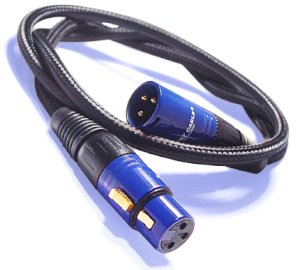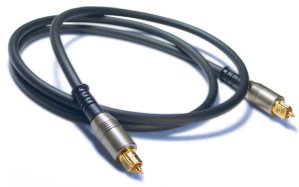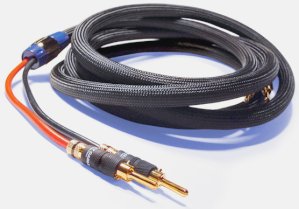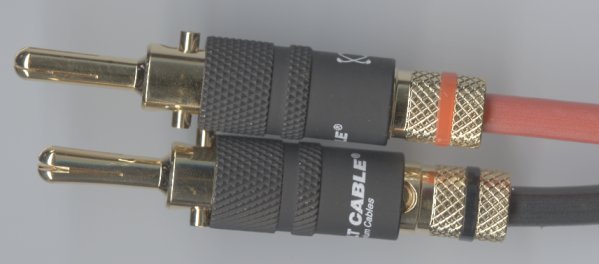|
|||||||||||||||||||||
|
Introduction Cables for connecting our A/V equipment together represent one of the most misunderstood - and often maligned - components in our A/V systems. When we shop for DVD players, receivers, speakers, and so on, the salesperson might say at the end, "Do you need any cables to go with that?" "Oh . . . yeah. I guess I do. So, what do you have?" If you bought a car, you wouldn't think to ask about getting tires, because (1) tires come with the car, and (2) we don't think of the tires as very important. Well, tires are very important to the driving experience. . . and so are cables, to our audio and home theater experiences. (By the way, you know that little plastic package of cables that comes with most mass market receivers and DVD players? Use it for skeet shooting the next time you are on the firing range.) Just as you don't need to spend a fortune on tires to have a nice ride, you don't have to plunk down a 1" thick pile of hundred dollar bills for cables to have great sound and video experiences. Sure, the big buck cables do have some fancy physics involved in the design, and many consumers swear by them for that last ounce of sound and picture quality. But, in general, a reasonable budget can get you that nice receiver, and some good cables too. There are lots of cable companies out there, just as there are lots of speaker companies, and other A/V product manufacturers. These days, cable companies have sprung up on-line, perhaps because wiring is a commodity, but also because they are light and easy to ship, and because often, we need custom lengths. This last factor isn't something that dealer showrooms can handle easily. So, ordering cables on-line is very popular now. Cobalt Cable Cobalt Cable has been around for a couple of years, and from what I see on our forum, they are a hot ticket. Like many other on-line cable suppliers, they have an OEM company actually do the construction for them. Cobalt supplies what they want as standards and features, the OEM company makes the raw cables and connectors, sends them to Cobalt, and Cobalt ships them out after assembling them for specific customer orders. Because there is no brick and mortar retail store, with overhead, Cobalt's prices are excellent. But so are the prices of the other on-line cable companies. So, what distinguishes the various cable companies, especially since many use the same OEM manufacturer (Belden)? Well, Belden is huge, and this means they can build cables to whatever standards and particular conductor configuration you want, and also customize the appearance, including a logo. Another popular OEM these days is China/Taiwan, which is where Cobalt gets their raw cables and connectors. Cobalt Cable uses a blue color (as in "cobalt blue") to distinguish the appearance. Judging from my experiences with the review samples that Cobalt sent to me, they tend towards very heavy conductors. This means you can more easily use them in long distance applications, and that is what I wanted to test, because the various components are really spread out in our test lab. I don't mean that I have to use a walkie-talkie to communicate with someone standing next to the rear speakers when I am fiddling with the DVD player, but let's just say that the cables we use most often are two-digit numbers in foot length. OK, so for the review units, the XLR cables were 10 meters long, the component video cables were 15 meters, and the speaker cables were 5 meters. The Toslink optical cable was 2 meters. In Use I have had the Cobalts for several months now, spread out all over our several listening rooms. As a matter of course in reviewing products, we plug and unplug, and plug in some more, and unplug some more. Although a typical consumer probably does not disconnect and reconnect cables as much as we do, this process does test the quality of construction. Some of the cables we have purchased in the past have ended up with frayed jackets and broken connectors. That did not happen with the Cobalts. They stayed the course, and are still being plugged and unplugged as I speak. No frays. No broken connectors. So, the heavy conductors seem to be combined with heavy duty soldering and connector parts. Excellent! I like not having to replace things. I was really expecting to find degradation in picture and sound quality due to the extraordinary lengths I was using, but it didn't happen. Undoubtedly, it is the heavy gauge conductors at work. The 30 foot XLR worked great, and so did the 50 foot component video cables. I used the XLR for subwoofers across the room, and the component video cables for going up the rear wall, across the top of the side wall, and down to the projector mounted below a soffit in the rear. Nice deep bass (my subs are flat to 15 Hz). Great picture. No hum. No video noise. No problem. I must say the Cobalt XLR cables are so much nicer than the "generic" XLR cables that I purchase by the box for various uses. The Cobalts have a sturdier shield and also use metal barrels, while the generics have a thinner cable profile overall and use plastic barrels. The gold contacts on the Cobalts will also prevent oxidation over time that could degrade signal transfer between plug and jack. The Cobalts use foamed polyethylene (PE) dielectric, which has a dielectric constant similar to Teflon (i.e., very low, and low is good). I suspect the generics just use plain old polyethylene. The Toslink optical cable uses metal connectors, and I like that better than the plastic ones I have seen. It's just more durable. The Cobalt speaker cables are also very heavy. This reduces the resistance and is preferable for higher powered amplifiers. The connectors that came with the review samples are optional locking bananas. A photo is shown below. First, you insert the banana into the speaker binding post, and then you rotate the dark gray sleeve until the banana pin expands enough to lock it into the binding post. The top connector in the photo is non-expanded (ready for insertion), and the bottom connector is expanded, which would lock it into place.
This, to me, is the way to go for banana plugs. I have had many experiences with conventional bananas coming out of the binding post sockets. It won't hurt anything, unless the loose plug shorts something out, but it is extremely annoying. The locking banana plugs add $20 to the cost of each cable, but they are worth it, especially since the Cobalts are stiff and very likely to tug a bit at the jacks. On the Bench The LCR data were about average for cables that we have tested. In particular, though, the resistance was very low for the speaker cables (lower than the other cables we have tested so far), which is a property we would expect from heavy conductors. This is great for long cable runs. Click HERE to see the data table. Below is a summary table of my evaluation of the Cobalt Cables.
Conclusions Cobalt Cable has a very good product. For situations where durability and long cable runs are issues, you can't go wrong with these guys.
|
|||||||||||||||||||||








